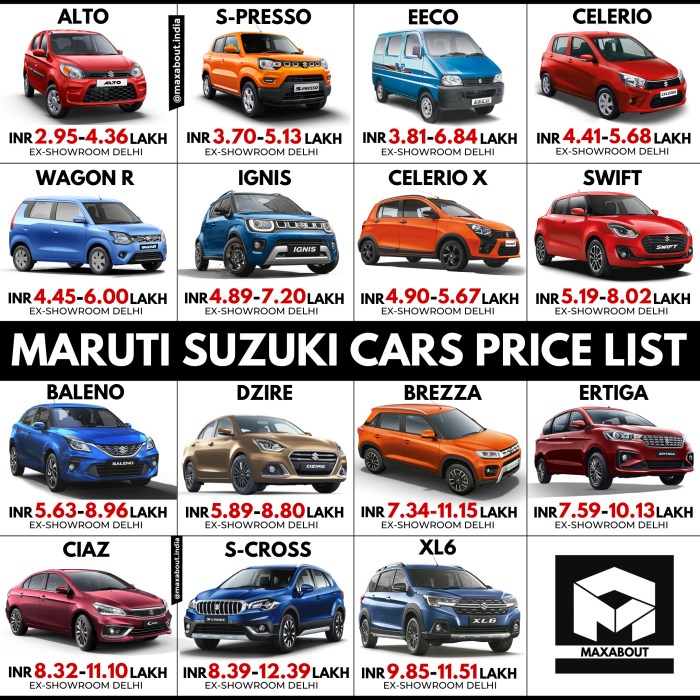Brand New Car Price List A Comprehensive Guide
Brand New Car Price List: A Comprehensive Guide
Brand new car price list – Purchasing a brand new car is a significant financial decision. Understanding the factors that influence pricing is crucial for making an informed choice. This guide explores various aspects of new car pricing, from manufacturer strategies to market trends, aiming to provide a clearer picture of the car market.
Exploring a brand new car price list can be a daunting task, especially with the sheer variety of models available. A significant player in the market, often commanding premium prices, is Tesla; you can find their current offerings by checking out this helpful resource on tesla car price brand new. Understanding Tesla’s pricing helps contextualize the broader brand new car price list and allows for more informed comparisons across different manufacturers.
Factors Influencing Brand New Car Prices
Several factors contribute to the wide variation in brand new car prices. Manufacturer reputation, production costs, technological advancements, and market demand all play significant roles. Luxury brands often incorporate higher-quality materials and advanced technologies, justifying higher price points. Conversely, budget brands prioritize affordability, sometimes sacrificing features for cost-effectiveness. Regional differences in taxes, import duties, and dealer markups also influence the final price a consumer pays.
Regional Price Variations
The price of a new car can differ significantly depending on the region. Factors such as local taxes, transportation costs, and dealer competition contribute to these variations. For example, a car might be more expensive in densely populated urban areas with higher demand and transportation costs compared to less populated rural regions.
Luxury vs. Budget Car Pricing Strategies
Luxury and budget car brands employ distinct pricing strategies. Luxury brands often utilize prestige pricing, emphasizing exclusivity and high-quality features to command premium prices. Budget brands, on the other hand, focus on competitive pricing, aiming to attract price-sensitive buyers with value-for-money propositions. This difference in strategy is clearly reflected in the final price tag.
| Car Segment | Average Price Range (USD) |
|---|---|
| Sedan | $20,000 – $60,000 |
| SUV | $25,000 – $80,000 |
| Truck | $30,000 – $70,000 |
Analyzing New Car Pricing Structures: Brand New Car Price List
The final price of a new car comprises several components, understanding these is essential for budget planning. These components can significantly impact the overall cost and should be carefully considered before purchase.
Components of the Final Price
The Manufacturer’s Suggested Retail Price (MSRP) forms the base price. However, several additional costs are typically added, including dealer fees, government taxes, and registration fees. These fees can vary significantly depending on the location and dealer.
Impact of Optional Features and Packages

Source: maxabout.us
Optional features and packages, such as advanced safety systems, premium sound systems, and luxury interior upgrades, can substantially increase the final price. Buyers should carefully evaluate the value proposition of these add-ons before opting for them.
Impact of Financing Options
Financing options, such as loans and leases, affect the monthly payment and the total cost of ownership. Longer loan terms result in lower monthly payments but increase the total interest paid. Leases typically have lower monthly payments but restrict mileage and require a return of the vehicle at the end of the lease term.
- Extended warranties
- Dealer add-ons (e.g., paint protection, fabric protection)
- Prepaid maintenance plans
- Interest charges on financing
Comparing Models and Brands
Comparing models and brands within the same segment allows consumers to assess value and features relative to price. This analysis can help in making a well-informed purchase decision.
Price Comparison of Compact SUVs

Source: hgmsites.net
Three popular compact SUVs, such as the Honda CR-V, Toyota RAV4, and Mazda CX-5, often exhibit price differences due to variations in standard features, fuel efficiency, and brand perception. The Honda CR-V might offer a more comprehensive standard features package, while the Mazda CX-5 might focus on sporty handling and design.
Key Features Justifying Price Differences

Source: d2cmedia.ca
Price differences between similar models from competing brands are often justified by variations in features, technology, fuel efficiency, and brand reputation. For instance, a higher price tag might reflect advanced driver-assistance systems, superior fuel economy, or a more prestigious brand image.
| Brand | Model | Fuel Type | Price (USD) |
|---|---|---|---|
| Toyota | Corolla | Gasoline | $22,000 |
| Honda | Civic | Gasoline | $23,000 |
| Ford | Escape | Hybrid | $28,000 |
| Tesla | Model 3 | Electric | $40,000 |
| Volkswagen | Golf | Diesel | $25,000 |
Exploring Market Trends in New Car Pricing
Several factors impact new car pricing trends, from global supply chain disruptions to technological advancements. Understanding these trends can help anticipate future price fluctuations.
Impact of Supply Chain Issues, Brand new car price list
Recent global supply chain disruptions have led to increased production costs and reduced vehicle availability, resulting in higher prices for new cars. The semiconductor shortage, for example, significantly impacted the production of many car models, leading to increased prices and longer waiting times.
Technological Advancements and Pricing
Technological advancements, such as the incorporation of advanced driver-assistance systems (ADAS) and electric powertrains, often increase the cost of new car models. These technologies often require specialized components and manufacturing processes, driving up the final price.
Government Regulations and Incentives for Electric Vehicles
Government regulations, such as stricter emission standards, and incentives, such as tax credits and subsidies, significantly influence the cost of electric vehicles (EVs). Government support aims to accelerate the adoption of EVs, but the regulatory environment can also impact production costs.
Future trends in new car pricing are likely to be influenced by the ongoing shift towards electric vehicles, advancements in autonomous driving technology, and the evolving global economic landscape. We can anticipate continued price fluctuations due to supply chain dynamics and the integration of new technologies. The increasing demand for sustainable transportation options may lead to higher prices for EVs initially, but economies of scale and technological advancements could eventually bring down costs.
The interplay of these factors will shape the future of new car pricing.
Illustrative Examples
Visualizing and understanding hypothetical scenarios can help clarify the impact of various factors on the final cost of a new car.
Price Difference: Base vs. Fully Loaded Model
Imagine a bar graph comparing the price of a base model sedan (e.g., $25,000) to a fully loaded version of the same model ($40,000). The bar for the fully loaded model would be significantly taller, visually representing the substantial price increase due to optional features and packages. The graph would clearly illustrate how added features significantly impact the overall cost.
Impact of Fuel Price Increase
A hypothetical 50% increase in fuel prices would significantly impact the overall cost of car ownership, especially for vehicles with low fuel efficiency. For example, a car that previously cost $50 per week in fuel might now cost $75, representing a considerable increase in running costs over the car’s lifespan.
Impact of Different Financing Options
Consider a $30,000 car financed over 36 months at 5% interest versus 60 months at 7% interest. The shorter-term loan would result in higher monthly payments but lower overall interest paid, while the longer-term loan would have lower monthly payments but significantly higher total interest paid over the loan’s duration. This illustrates how financing choices significantly influence the total cost of ownership.
Answers to Common Questions
What is MSRP?
MSRP stands for Manufacturer’s Suggested Retail Price. It’s the price the manufacturer recommends the dealer sell the vehicle for, but it’s often negotiable.
How much should I expect to pay in dealer fees?
Dealer fees vary significantly by location and dealership. It’s crucial to negotiate these fees, as they can add substantially to the final price.
What are some hidden costs of car ownership?
Hidden costs can include insurance, registration, taxes, maintenance, and potential repairs. Budgeting for these expenses is crucial.
How do interest rates affect my monthly car payment?
Higher interest rates lead to higher monthly payments and a greater overall cost of the loan. Shopping around for financing is essential.





















